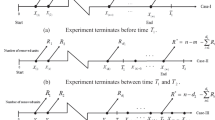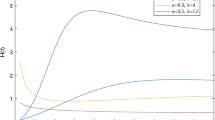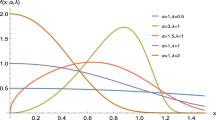Abstract
Adaptive Type-II progressive hybrid censoring scheme has been proposed to increase the efficiency of statistical analysis and save the total test time on a life-testing experiment. This article deals with the problem of estimating the parameters, survival and hazard rate functions of the two-parameter Hjorth distribution under adaptive Type-II progressive hybrid censoring scheme using maximum likelihood and Bayesian approaches. The two-sided approximate confidence intervals of the unknown quantities are constructed. Under the assumption of independent gamma priors, the Bayes estimators are obtained using squared error loss function. Since the Bayes estimators cannot be expressed in closed forms, Lindley’s approximation and Markov chain Monte Carlo methods are considered and the highest posterior density credible intervals are also obtained. To study the behavior of the various estimators, a Monte Carlo simulation study is performed. The performances of the different estimators have been compared on the basis of their average root mean squared error and relative absolute bias. Finally, to show the applicability of the proposed estimators a data set of industrial devices has been analyzed.




Similar content being viewed by others
References
Aarset MV (1987) How to identify a bathtub hazard rate. IEEE Transactions on Reliability 36(1):106–108
Ahmed EA (2014) Bayesian estimation based on progressive Type-II censoring from two-parameter bathtub-shaped lifetime model: an Markov chain Monte Carlo approach. Journal of Applied Statistics 41(4):752–768
AL Sobhi MM, Soliman AA (2016) Estimation for the exponentiated Weibull model with adaptive Type-II progressive censored schemes. Applied Mathematical Modelling 40(2):1180–1192
Ashour SK, Nassar MMA (2014) Analysis of generalized exponential distribution under adaptive Type-II progressive hybrid censored competing risks data. International Journal of Advanced Statistics and Probability 2(2):108–113
Bdair OM, Awwad RA, Abufoudeh GK, Naser MFM (2019) Estimation and prediction for flexible Weibull distribution based on progressive Type II censored data. Communications in Mathematics and Statistics. https://doi.org/10.1007/s40304-018-00173-0
Balakrishnan N, Cramer E (2014) The Art of Progressive Censoring. Statistics for Industry and Technology, Springer, Birkhäuser, New York
Balakrishnan N, Sandhu RA (1995) A simple simulational algorithm for generating progressive Type-II censored samples. The American Statistician 49(2):229–230
Chen MH, Shao QM (1999) Monte Carlo estimation of Bayesian credible and HPD intervals. Journal of Computational and Graphical Statistics 8(1):69–92
Cohen AC (1965) Maximum likelihood estimation in the Weibull distribution based on complete and on censored samples. Technometrics 7(4):579–588
Greene WH (2012) Econometric Analysis, 7th edn. Pearson Prentice-Hall, Upper Saddle River, New Jersey
Hastings WK (1970) Monte Carlo sampling methods using Markov chains and their applications. Biometrika 57:97–109
Hemmati F, Khorram E (2017) On adaptive progressively Type-II censored competing risks data. Communications in Statistics-Simulation and Computation 46(6):4671–4693
Henningsen A, Toomet O (2011) ’maxLik’: A package for maximum likelihood estimation in R. Computational Statistics 26(3):443–458
Hjorth U (1980) A reliability distribution with increasing, decreasing, constant and bathtub-shaped failure rates. Technometrics 22(1):99–107
Ismail AA (2014) Inference for a step-stress partially accelerated life test model with an adaptive Type-II progressively hybrid censored data from Weibull distribution. Journal of Computational and Applied Mathematics 260:533–542
Jiang R (2013) A new bathtub curve model with a finite support. Reliability Engineering and System Safety 119:44–51
Kayal T, Tripathi YM, Singh DP, Rastogi MK (2017) Estimation and prediction for Chen distribution with bathtub shape under progressive censoring. Journal of Statistical Computation and Simulation 87(2):348–366
Kohansal A, Bakouch HS (2019) Estimation procedures for Kumaraswamy distribution parameters under adaptive Type-II hybrid progressive censoring. Communications in Statistics-Simulation and Computation. https://doi.org/10.1080/03610918.2019.1639734
Kundu D, Joarder A (2006) Analysis of Type-II progressively hybrid censored data. Computational Statistics and Data Analysis 50(10):2509–2528
Lindley DV (1980) Approximate Bayesian methods. Trab. Estadistica. 31(1):223–245
Mahmoud MAW, Soliman AA, Abd-Ellah AH, El-Sagheer RM (2013) Estimation of generalized Pareto under an adaptive Type-II progressive censoring. Intelligent Information Management. 5(3):73–83
Metropolis N, Rosenbluth AW, Rosenbluth MN, Teller AH, Teller E (1953) Equation of state calculations by fast computing machines. Journal Chemical Physics. 21(6):1087–1091
Nadarajah S (2009) Bathtub-shaped failure rate functions. Quality and Quantity 43(5):855–863
Nassar M, Abo-Kasem OE (2017) Estimation of the inverse Weibull parameters under adaptive Type-II progressive hybrid censoring scheme. Journal of computational and applied mathematics 315:228–239
Nassar M, Abo-Kasem OE, Zhang C, Dey S (2018) Analysis of Weibull Distribution Under Adaptive Type-II Progressive Hybrid Censoring Scheme. Journal of the Indian Society for Probability and Statistics 19(1):25–65
Ng HKT, Kundu D, Chan PS (2009) Statistical analysis of exponential lifetimes under an adaptive Type-II progressive censoring scheme. Naval Research Logistics 56(8):687–698
Panahi H, Moradi N (2020) Estimation of the inverted exponentiated Rayleigh distribution based on adaptive Type-II progressive hybrid censored sample. Journal of Computational and Applied Mathematics 364:112345
Pavia JM (2015) Testing goodness-of-fit with the kernel density estimator: GoFKernel. Journal of Statistical Software 66(1):1–27
Plummer M, Best N, Cowles K, Vines K (2006) ’coda’: convergence diagnosis and output analysis for MCMC. R news 6(1):7–11
Pushkarna N, Saran J, Verma K (2020) Progressively Type-II right censored order statistics from Hjorth distribution and related inference. Statistics, Optimization and Information Computing 8(2):481–498
Rastogi MK, Tripathi YM, Wu SJ (2012) Estimating the parameters of a bathtub-shaped distribution under progressive type-II censoring. Journal of Applied Statistics 39(11):2389–2411
Xu, R., Gui, W.: Entropy Estimation of Inverse Weibull Distribution under adaptive Type-II progressive hybrid censoring schemes. Symmetry, 11(12) (2019) https://doi.org/10.3390/sym11121463
Yadav AS, Bakouch HS, Chesneau C (2019) Bayesian estimation of the survival characteristics for Hjorth distribution under progressive type-II censoring. Communications in Statistics-Simulation and Computation. https://doi.org/10.1080/03610918.2019.1659363
Zhang C, Shi Y (2016) Estimation of the extended Weibull parameters and acceleration factors in the step-stress accelerated life tests under an adaptive progressively hybrid censoring data. Journal of Statistical Computation and Simulation 86(16):3303–3314
Acknowledgements
The authors would like to express thanks to the Editor-in-Chief Prof. Wataru Sakamoto, and two anonymous referees for their constructive comments and suggestions, which significantly improved the paper.
Author information
Authors and Affiliations
Corresponding author
Additional information
Publisher's Note
Springer Nature remains neutral with regard to jurisdictional claims in published maps and institutional affiliations.
Supplementary Information
Below is the link to the electronic supplementary material.
Rights and permissions
About this article
Cite this article
Elshahhat, A., Nassar, M. Bayesian survival analysis for adaptive Type-II progressive hybrid censored Hjorth data. Comput Stat 36, 1965–1990 (2021). https://doi.org/10.1007/s00180-021-01065-8
Received:
Accepted:
Published:
Issue Date:
DOI: https://doi.org/10.1007/s00180-021-01065-8
Keywords
- Adaptive Type-II progressive hybrid censoring scheme
- Bayes estimator
- Metropolis-Hasting algorithm
- Hjorth distribution
- Lindley’s approximation method
- Maximum likelihood estimator
- Reliability characteristics




